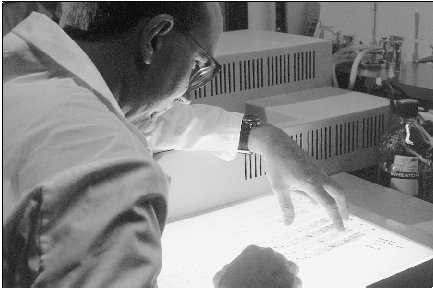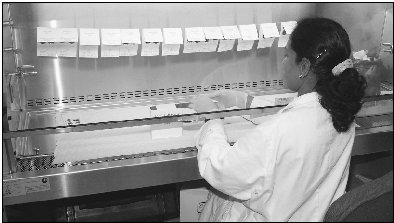Chapter 5
Genes and the Law
Besides blazing new paths in health science, genetics is transforming the way in which criminal investigations and trials are conducted. The importance of DNA evidence rests on a single but crucial fact: Every individual's DNA is unique (except in the case of identical twins, who have identical genomes). A person's DNA profile can be used like a fingerprint to link suspects to crime scenes and victims. DNA profiling—also called DNA fingerprinting or DNA typing—has been responsible for overturning verdicts and saving innocent people from execution. The process is complicated and controversial. Nevertheless, it has earned itself a place in police probes and courtroom proceedings, and the science behind it is compelling enough that it is likely to play a major role in the future.
The Battle over DNA
Proponents of DNA analysis had to fight against strenuous opposition before the judicial system consented to recognize its validity in courtroom proceedings. "In its early days, DNA was highly controversial and not always accepted by the courts," says James F. Crow of the Genetics Department at the University of Wisconsin in Madison:
The arguments and uncertainties led to a study by the National Academy of Sciences. Publication of this report started with a bang. A badly mangled report by the usually reliable New York Times implied that there should be a moratorium on DNA use. This was followed the next day by a front page retraction. The [National Academy of Sciences] report had made no such recommendation, although it raised a number of questions about the techniques and their interpretation. 33
The NSF conducted further studies and concluded that DNA was, in fact, a valid tool in criminal investigation. "We strongly believe that DNA testing properly performed belongs in the courtroom," say Howard Coleman and Eric Swenson in a guide to the subject prepared for journalists.
We share this view with the U.S. Congress Office of Technology Assessment, the National Academy of Sciences and the vast majority of scientists in America. The continuing controversy over the admissibility of DNA evidence makes little sense except to the very few people who benefit from continued confusion.
The DNA war is a clash of the different approaches of law and science. It would be difficult to think of two disciplines that have more disparate approaches to seeking the truth. Scientific truth evolves by the building of consensus through peer review and the replicating of experiments. For the law, truth is less absolute and more relative to the case at hand. Legal truth is achieved through adversarial argument and judgment. The DNA war is a dramatic, hard-fought conflict between these two worlds. 34
DNA evidence can be gathered from a wide variety of sources, including blood, semen, hair, fingernails and toenails, saliva, urine, skin, and other body tissues. The DNA of every human being is 99.9 percent

Noncoding DNA, or junk DNA as it is also called, is characterized by sequences of letters (As, Ts, Cs, and Gs) that repeat in a regular manner up to thirty times in a row. These patterns are called variable number tandem repeats (VNTRs), and it is extremely unlikely that any two individuals will have similar patterns of repeating junk DNA provided that a sufficiently large number of patterns are observed. The key circumstance in DNA evidence is that the number of VNTRs at specific locations on the chromosomes differs between individuals. The fundamental technique used to determine a DNA profile is called restriction fragment length polymorphisms (RFLPs). This complicated phrase simply means that investigators determine the number of VNTR repeats at a series of distractive locations in order to come up with an individual's profile. An alternative method is to use a polymerase chain reaction (PCR). RFLP testing requires more DNA, from 20 to 50 billionths of a gram, to be accurate. PCR requires only 2 billionths of a gram.
DNA Profiles
To create a DNA profile, the following steps must be followed. First, DNA is taken from the crime scene. The DNA can come from any body fluid or tissue left behind. The DNA must be cleaned up to make sure that it has not been contaminated by dust, soil, carpet fibers, or other extraneous substances. Every cell will contain a complete copy of the subject's entire genome, far too much genetic material to be analyzed all at once. Therefore, the DNA is cut into manageable pieces using restriction enzymes that were developed as part of the tool kit of genetic engineering. The choice of which restriction enzymes to use is important. They should not cut the DNA within the VNTR locations that are being examined. Ideally, they should do their work just outside a VNTR region.
Once the DNA has been reduced to fragments, the pieces, which range in size from one hundred to ten thousand base pairs, are sorted according to length. The process used to do this is called gel electrophoresis. The DNA fragments are placed on a flat tray in a chemical gel called agarose. The tray is then placed in an electric field. Since the DNA has a negative charge, it will be pulled toward the positive electrode, and larger pieces will progress more slowly than smaller ones. The relative size of each fragment of DNA is determined by how far it has moved through the agarose in a given period of time.
To prevent the fragments of DNA from decomposing, they are uncoiled from their spiral (double helix) form and affixed to a nylon membrane that has been treated with preservatives. The DNA pieces are then attached to radioactive probes that identify each VNTR location. The radioactive probe can be photographed on X-ray film to provide a visual image of the microscopic letters in the VNTR sequence. These show up on the film as a series of dark bands that appear similar to the bar codes on consumer items. To obtain a complete genetic profile, this procedure has to be repeated for a number of VNTR locations on different chromosomes. If the profile is based on thirteen different locations, the standard used by the Federal Bureau of Investigation (FBI) and many other law enforcement organizations, the chances that the DNA sample can be linked to the wrong individual are approximately one in 100 billion.
However, crime scenes can be very messy places. DNA from the victim, or victims if there are more than one, frequently gets mixed with that of the suspect or suspects. The precision of DNA profiling is often complicated by these and other circumstances. "The interpretation of the data . . . requires that inferences based on the science of statistics, population genetics and probability theory be applied to

DNA's Courtroom Debut
DNA evidence was first used in a courtroom in the mid-1980s. In one early case, it was employed to exonerate one suspect and convict another. Police in the East Midlands area of England were struggling to solve the brutal rape and murder of two schoolgirls. Their prime suspect was a kitchen worker at a nearby mental hospital. The police brought samples of the worker's blood and samples of semen taken from the crime scenes to geneticist Alec Jeffreys at the University of Leicester for analysis. Jeffreys was able to conclude that the same person had committed both crimes, but that the perpetrator was not the kitchen worker.
Police were convinced that the killer was a local resident, so they requested that every male in town between the ages of seventeen and thirty-four submit a blood sample for testing. Within a few months more than 4,583 DNA tests had been performed and none of them matched the DNA retrieved from the crime scene semen. The authorities were about to fall back on more conventional investigative methods when they were informed by a bakery manager that one of her employees, a man named Colin Pitchfork, had persuaded a coworker to be tested in his place. When officers confronted Pitchfork, he confessed to the rapes and murders. When the police lab tested his DNA, they found it matched perfectly the samples taken from the sites where the two girls were killed.
The date was September 1987, and DNA testing has been a vital tool in criminal investigations ever since. DNA testing spread from England to America, where it quickly became a major weapon in the war against crime. The mass media hailed it as a virtually infallible way to determine guilt or innocence. Even judges were overwhelmed by its apparent ability to cut through the often confusing and inconclusive nature of other forms of evidence. One judge, Joseph Harris, of Albany, New York, proclaimed that DNA evidence was the "greatest single advance in the search for truth since the advent of cross-examination." 36
At first, defense attorneys were powerless to challenge the apparent certitude of DNA evidence. In more than a hundred cases, genetics played the decisive role in getting a conviction. Some legal experts felt that the phenomenon was eroding a defendant's right to a fair trial. "In rape cases, when the semen has been matched with the defendant's and the chance that it came from another person is 33 billion to one, you don't need a jury," 37 complained lawyer Robert Bowser. But chinks soon began to appear in the seemingly invincible DNA armor—not because the science was faulty, but because the tests were extremely complicated and the laboratories where they were conducted were prone to error.
DNA Challenged
The first case on which DNA evidence was successfully disputed took place in New York in 1987. A woman named Vilma Ponce, who was seven months pregnant, was found dead with more than sixty stab wounds on her body. Her two-year-old daughter lay murdered in a similarly brutal way in the bathroom of Ponce's apartment. The principal suspect was José Castro, a janitor in a nearby apartment building. Detectives found a blood stain on his watch. DNA tests conducted by an independent laboratory indicated that the blood on Castro's watch matched Ponce's blood. The odds against the blood being from someone else were put at one in 189 million.
Castro's defense lawyer challenged the test results and produced witnesses who testified that the lab had not followed accepted procedures. The DNA evidence was thrown out of court and Castro appeared to be on his way to acquittal when he suddenly confessed to the crime. The DNA evidence was correct, but it was not allowed to be presented to the jury because the laboratory's procedures for handling such evidence were deemed to be too lax.
The scientific basis of applying genetics to criminal proceedings has never been questioned; what has neutralized much such evidence has been sloppiness on the part of lab technicians and police investigators in handling the samples upon which the DNA tests were conducted. The most famous trial in which DNA evidence played a role was that of former football star O.J. Simpson, who was accused in 1994 of murdering his ex-wife, Nicole Brown Simpson, and her friend Ron Goldman. The prosecution produced DNA evidence that appeared overwhelmingly to link Simpson to the crime scene. Yet the jury refused to convict him. His defense attorneys did not challenge the validity of DNA testing in general. In fact, they distanced themselves from the laboratory procedures that were done. What they did attack—successfully—was how police investigators handled the blood samples once they had been collected. By focusing on breaks in the chain of evidence, how samples were passed from one investigator to another, how long and under what circumstances they were stored, and a number of other irregularities, the defense team managed to convince the jury that the possibility existed that the samples had been tampered with. It was enough to create "reasonable doubt" as to Simpson's guilt in the minds of the jurors and led to his acquittal. Again, the scientific basis of DNA analysis was never in question, but science alone was not the deciding factor in the outcome of the trial.

Paternity Testing
Determining guilt or innocence in criminal investigations is not the only application of DNA technology to legal matters. The technique is used even more frequently in paternity testing, with approximately two hundred thousand such tests being performed every year. It has all but supplanted conventional blood tests as a convenient, accurate way to determine the identity of a child's father. While blood tests can conclusively prove that a man is not the father of a child, they cannot determine beyond doubt that he is.
DNA tests, on the other hand, provide almost 100 percent assurance in either case. Moreover, blood tests must be performed by licensed doctors, whereas DNA tests can be done by a wide range of qualified technicians. In many cases, all that is required is a cotton swab rubbed on the inside of the cheek. In addition, blood tests could not be performed on babies until they were six months old. DNA samples can be taken immediately after birth—or while the baby is still in the womb. Finally, DNA can be obtained from the remains of a deceased father to establish whether or not a child is entitled to a share of his estate.
Paternity testing is possible because every individual contains two copies, or alleles, of every gene, one from the mother and the other from the father. If a child has an allele that did not come from the mother, then it must have come from the biological father. Conversely, if the allele in question is shown not to have come from the suspected father, paternity is disproved.
"Most paternity testing is done for financial reasons, i.e. to establish legal responsibility and provide for child support," say Coleman and Swenson.
Even more important are the emotional and social issues. When testing can demonstrate conclusively to a man that he is the father of a child, then he is more likely to provide not only financial support, but emotional support as well. He may bond with the child and take an active part in its life. . . . It wasn't very long ago that obtaining a paternity test was an uncertain, expensive and inconvenient process. . . . DNA testing has made the process convenient and the result conclusive. In all but the rarest of instances, the DNA test results provide a level of certainty so high that paternity will, for all practical purposes, be proven or disproved. 38
Streamlining the Justice System
DNA paternity tests can also be used to prove childhood sexual abuse. Often in these cases, the allegation is not made until years after the event, when physical evidence that a crime has taken place is no longer available. If the abuse resulted in pregnancy, the tests can easily and definitively determine paternity and hence identify the perpetrator.
Barry Scheck, one of O.J. Simpson's defense attorneys, is the cofounder of the Innocence Project, an organization that has been fighting to get false convictions overturned on the basis of DNA evidence. He believes that genetic testing will streamline the criminal justice system by enabling police to determine at a preliminary stage whether a suspect was at the scene of the crime independently of often unreliable eyewitness testimony. "One of the things that we have to recognize about DNA testing is that we can use it . . . in an earlier stage of the investigation than it is being used today," Scheck says. "We can take smaller amounts of sample and test them at the beginning of the investigation. . . . We can now use DNA to get suspects and to eliminate the wrong people very, very early in the investigation." 39
Scheck insists that the key to the success of DNA testing in the courts is the proper handling of samples by the police and by the laboratories where the tests are carried out. "DNA testing is truly revolutionary," he says. "It's transforming the way we do business in the criminal justice system. And it's only beginning. That's one reason why it's very important to make sure that the testing itself is done correctly, is done with the highest standards of quality assurance so that we don't make mistakes." 40
Scheck believes that DNA testing will be able to exonerate many innocent people who are now in prison after having been falsely convicted on the basis of other types of evidence. It can also shed light on troubling, unsolved cases and prevent further crime by getting dangerous individuals off the streets. "We can go back to these old cases and see whether or not the system made mistakes," he says. "We can look at old, unsolved cases and find the real perpetrator." 41
Finally, DNA testing, because it is relatively cheap, can help accused people with few resources at their disposal mount an effective defense. Scheck cites the Simpson case, in which, despite the Hall-of-Fame football player's wealth and the top-quality lawyers it enabled him to hire, the prosecution still had a preponderance of resources on its side. "The prosecution had 47 prosecutors working on the case. FBI, Interpol, the Los Angeles Police Department, the crime lab had tremendous resources, much greater than ours, but the point was . . . we were able to demonstrate that a lot of things went wrong." 42
Comment about this article, ask questions, or add new information about this topic: